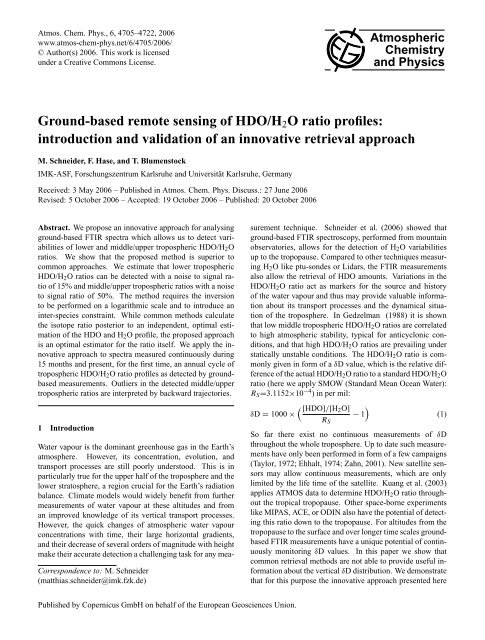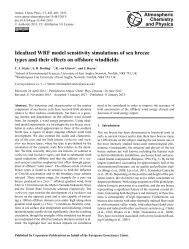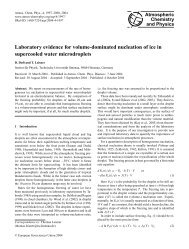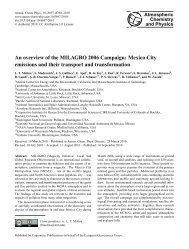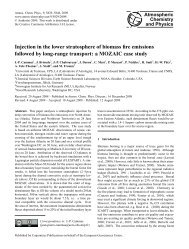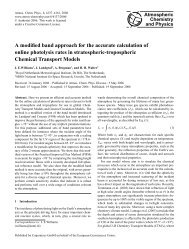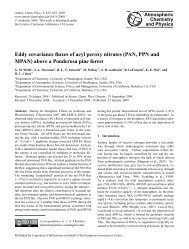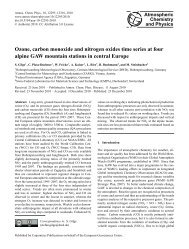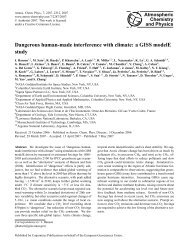Ground-based remote sensing of HDO/H2O ratio - Atmospheric ...
Ground-based remote sensing of HDO/H2O ratio - Atmospheric ...
Ground-based remote sensing of HDO/H2O ratio - Atmospheric ...
You also want an ePaper? Increase the reach of your titles
YUMPU automatically turns print PDFs into web optimized ePapers that Google loves.
Atmos. Chem. Phys., 6, 4705–4722, 2006<br />
www.atmos-chem-phys.net/6/4705/2006/<br />
© Author(s) 2006. This work is licensed<br />
under a Creative Commons License.<br />
<strong>Atmospheric</strong><br />
Chemistry<br />
and Physics<br />
<strong>Ground</strong>-<strong>based</strong> <strong>remote</strong> <strong>sensing</strong> <strong>of</strong> <strong>HDO</strong>/<strong>H2O</strong> <strong>ratio</strong> pr<strong>of</strong>iles:<br />
introduction and validation <strong>of</strong> an innovative retrieval approach<br />
M. Schneider, F. Hase, and T. Blumenstock<br />
IMK-ASF, Forschungszentrum Karlsruhe and Universität Karlsruhe, Germany<br />
Received: 3 May 2006 – Published in Atmos. Chem. Phys. Discuss.: 27 June 2006<br />
Revised: 5 October 2006 – Accepted: 19 October 2006 – Published: 20 October 2006<br />
Abstract. We propose an innovative approach for analysing<br />
ground-<strong>based</strong> FTIR spectra which allows us to detect variabilities<br />
<strong>of</strong> lower and middle/upper tropospheric <strong>HDO</strong>/<strong>H2O</strong><br />
<strong>ratio</strong>s. We show that the proposed method is superior to<br />
common approaches. We estimate that lower tropospheric<br />
<strong>HDO</strong>/<strong>H2O</strong> <strong>ratio</strong>s can be detected with a noise to signal <strong>ratio</strong><br />
<strong>of</strong> 15% and middle/upper tropospheric <strong>ratio</strong>s with a noise<br />
to signal <strong>ratio</strong> <strong>of</strong> 50%. The method requires the inversion<br />
to be performed on a logarithmic scale and to introduce an<br />
inter-species constraint. While common methods calculate<br />
the isotope <strong>ratio</strong> posterior to an independent, optimal estimation<br />
<strong>of</strong> the <strong>HDO</strong> and <strong>H2O</strong> pr<strong>of</strong>ile, the proposed approach<br />
is an optimal estimator for the <strong>ratio</strong> itself. We apply the innovative<br />
approach to spectra measured continuously during<br />
15 months and present, for the first time, an annual cycle <strong>of</strong><br />
tropospheric <strong>HDO</strong>/<strong>H2O</strong> <strong>ratio</strong> pr<strong>of</strong>iles as detected by ground<strong>based</strong><br />
measurements. Outliers in the detected middle/upper<br />
tropospheric <strong>ratio</strong>s are interpreted by backward trajectories.<br />
1 Introduction<br />
Water vapour is the dominant greenhouse gas in the Earth’s<br />
atmosphere. However, its concent<strong>ratio</strong>n, evolution, and<br />
transport processes are still poorly understood. This is in<br />
particularly true for the upper half <strong>of</strong> the troposphere and the<br />
lower stratosphere, a region crucial for the Earth’s radiation<br />
balance. Climate models would widely benefit from further<br />
measurements <strong>of</strong> water vapour at these altitudes and from<br />
an improved knowledge <strong>of</strong> its vertical transport processes.<br />
However, the quick changes <strong>of</strong> atmospheric water vapour<br />
concent<strong>ratio</strong>ns with time, their large horizontal gradients,<br />
and their decrease <strong>of</strong> several orders <strong>of</strong> magnitude with height<br />
make their accurate detection a challenging task for any mea-<br />
Correspondence to: M. Schneider<br />
(matthias.schneider@imk.fzk.de)<br />
Published by Copernicus GmbH on behalf <strong>of</strong> the European Geosciences Union.<br />
surement technique. Schneider et al. (2006) showed that<br />
ground-<strong>based</strong> FTIR spectroscopy, performed from mountain<br />
observatories, allows for the detection <strong>of</strong> <strong>H2O</strong> variabilities<br />
up to the tropopause. Compared to other techniques measuring<br />
<strong>H2O</strong> like ptu-sondes or Lidars, the FTIR measurements<br />
also allow the retrieval <strong>of</strong> <strong>HDO</strong> amounts. Variations in the<br />
<strong>HDO</strong>/<strong>H2O</strong> <strong>ratio</strong> act as markers for the source and history<br />
<strong>of</strong> the water vapour and thus may provide valuable information<br />
about its transport processes and the dynamical situation<br />
<strong>of</strong> the troposphere. In Gedzelman (1988) it is shown<br />
that low middle tropospheric <strong>HDO</strong>/<strong>H2O</strong> <strong>ratio</strong>s are correlated<br />
to high atmospheric stability, typical for anticyclonic conditions,<br />
and that high <strong>HDO</strong>/<strong>H2O</strong> <strong>ratio</strong>s are prevailing under<br />
statically unstable conditions. The <strong>HDO</strong>/<strong>H2O</strong> <strong>ratio</strong> is commonly<br />
given in form <strong>of</strong> a δD value, which is the relative difference<br />
<strong>of</strong> the actual <strong>HDO</strong>/<strong>H2O</strong> <strong>ratio</strong> to a standard <strong>HDO</strong>/<strong>H2O</strong><br />
<strong>ratio</strong> (here we apply SMOW (Standard Mean Ocean Water):<br />
RS=3.1152×10−4 ) in per mil:<br />
�<br />
[<strong>HDO</strong>]/[<strong>H2O</strong>]<br />
�<br />
δD = 1000 ×<br />
− 1<br />
(1)<br />
RS<br />
So far there exist no continuous measurements <strong>of</strong> δD<br />
throughout the whole troposphere. Up to date such measurements<br />
have only been performed in form <strong>of</strong> a few campaigns<br />
(Taylor, 1972; Ehhalt, 1974; Zahn, 2001). New satellite sensors<br />
may allow continuous measurements, which are only<br />
limited by the life time <strong>of</strong> the satellite. Kuang et al. (2003)<br />
applies ATMOS data to determine <strong>HDO</strong>/<strong>H2O</strong> <strong>ratio</strong> throughout<br />
the tropical tropopause. Other space-borne experiments<br />
like MIPAS, ACE, or ODIN also have the potential <strong>of</strong> detecting<br />
this <strong>ratio</strong> down to the tropopause. For altitudes from the<br />
tropopause to the surface and over longer time scales ground<strong>based</strong><br />
FTIR measurements have a unique potential <strong>of</strong> continuously<br />
monitoring δD values. In this paper we show that<br />
common retrieval methods are not able to provide useful information<br />
about the vertical δD distribution. We demonstrate<br />
that for this purpose the innovative approach presented here
4706 M. Schneider et al.: <strong>Ground</strong>-<strong>based</strong> <strong>remote</strong> <strong>sensing</strong> <strong>of</strong> <strong>HDO</strong>/<strong>H2O</strong> <strong>ratio</strong> pr<strong>of</strong>iles<br />
Fig. 1. Typical δD pr<strong>of</strong>ile and its variability as derived from the data<br />
<strong>of</strong> Ehhalt (1974). Black crosses: Queen Air flights; black circles:<br />
Sabreliner flights; red line: a-priori δD applied in this work.<br />
Fig. 2. δD a-priori correlation matrix as derived from the data <strong>of</strong><br />
Ehhalt (1974).<br />
has to be applied. In addition this approach supports the development<br />
<strong>of</strong> innovative satellite retrieval codes.<br />
2 A-priori knowledge <strong>of</strong> <strong>HDO</strong> and <strong>H2O</strong><br />
Tropospheric water vapour mixing <strong>ratio</strong>s are log-normally<br />
distributed. This was shown, for example, in Schneider et al.<br />
(2006) by an analysis <strong>of</strong> ptu-sonde data measured from 1999<br />
to 2003. Measurements <strong>of</strong> <strong>HDO</strong>/<strong>H2O</strong> pr<strong>of</strong>iles are relatively<br />
rare. One <strong>of</strong> the most extensive <strong>HDO</strong>/<strong>H2O</strong> datasets is from<br />
Ehhalt (1974). It consists <strong>of</strong> measurements performed during<br />
two major phases. During the first phase, between 1965 and<br />
1967, the Queen Air 80 airplane was used as platform. It allowed<br />
to measure up to an altitude <strong>of</strong> 9 km. The second phase<br />
in 1971/72 focused on higher altitudes. The applied Sabreliner<br />
airplane allowed to reach altitudes up to 13 km. Figure 1<br />
collects these measurements. It shows the mean δD and its<br />
variability (as error bars). The mean Sabreliner values systematically<br />
exceed the mean Queen Air values. The reason<br />
might be the locations <strong>of</strong> the measurements: while the Queen<br />
Air data are from a variety <strong>of</strong> measurement sites (continental<br />
mid-latitudes, marine subtropical region,...), the Sabreliner<br />
data are mainly from a continental mid-latitude site (Scottsbluff,<br />
Nebraska). In this work we assumed a δD pr<strong>of</strong>ile for<br />
Izaña as depicted as red line in Fig. 1. Above 13 km we assumed<br />
a δD value <strong>of</strong> −350, which is in good agreement with<br />
Abbas et al. (1987).<br />
Besides the mean and the variability, the Ehhalt (1974)<br />
data may give information about the typical correlations <strong>of</strong><br />
the <strong>HDO</strong>/<strong>H2O</strong> <strong>ratio</strong> between different altitudes. Figure 2<br />
shows the relevant correlation matrix (Ɣa). The covariance<br />
matrix is calculated from Ɣa by Sa=�aƔa� T a<br />
, where �a<br />
is a diagonal matrix containing the variabilities for a certain<br />
altitude. It is found that both datasets yield similar correlation<br />
patterns in the overlapping altitude region. For the lower<br />
troposphere the correlation length (distance within the correlation<br />
coefficient reduces to e−1/2 ) is 5 km and with increasing<br />
altitudes it rapidly decreases. Above 5 km it is around<br />
2.5 km. For the simulations performed in this work we constructed<br />
a <strong>HDO</strong> pr<strong>of</strong>ile for each <strong>H2O</strong> pr<strong>of</strong>ile, in the way that<br />
the ensemble as a whole obeys the <strong>HDO</strong>/<strong>H2O</strong> statistics derived<br />
from the Ehhalt (1974) data. This is possible by as-<br />
suming that<br />
δD<br />
1000<br />
+1 is log-normally distributed. This is a<br />
justified assumption since the δD values are to a large extent<br />
concentrated close to a Rayleigh distillation curve but turbulent<br />
and convective transport occasionally produce very high<br />
δD values: δD is more log-normal than normal distributed.<br />
On logarithmic scale Eq. (1) can be rewritten as:<br />
ln([<strong>HDO</strong>])= ln( δD<br />
1000 + 1) + ln(RS) + ln([<strong>H2O</strong>]) (2)<br />
From the Ehhalt (1974) data we derive the mean and covariance<br />
<strong>of</strong> ln( δD<br />
1000 +1), which we apply to simulate <strong>HDO</strong> pr<strong>of</strong>iles<br />
for the whole ensemble <strong>of</strong> <strong>H2O</strong> pr<strong>of</strong>iles. The ensemble<br />
<strong>of</strong> <strong>H2O</strong> pr<strong>of</strong>iles is the same as in Schneider et al. (2006). The<br />
pr<strong>of</strong>ile pairs are used for the theoretical error estimation and<br />
sensitivity assessment shown in Sect. 5.<br />
3 General retrieval aspects<br />
In this study PROFFIT (Hase et al., 2004) is the inversion<br />
code used. It applies the Karlsruhe Optimised and Precise<br />
Radiative Transfer Algorithm (KOPRA, Höpfner et al., 1998;<br />
Kuntz et al., 1998; Stiller et al., 1998) as the forward model,<br />
Atmos. Chem. Phys., 6, 4705–4722, 2006 www.atmos-chem-phys.net/6/4705/2006/
M. Schneider et al.: <strong>Ground</strong>-<strong>based</strong> <strong>remote</strong> <strong>sensing</strong> <strong>of</strong> <strong>HDO</strong>/<strong>H2O</strong> <strong>ratio</strong> pr<strong>of</strong>iles 4707<br />
which was developed for the analysis <strong>of</strong> MIPAS-Envisat limb<br />
sounder spectra. PROFFIT enables the inversion on a linear<br />
and logarithmic scale. The code does not employ a fixed apriori<br />
value for the measurement noise. This value is taken<br />
from the residuals <strong>of</strong> the fit itself, performing an automatic<br />
adjustment <strong>of</strong> the constraints. Furthermore, if the observed<br />
absorptions depend on temperature, PROFFIT allows the retrieval<br />
<strong>of</strong> temperature pr<strong>of</strong>iles.<br />
We analysed <strong>H2O</strong> and <strong>HDO</strong> signatures in the mid-infrared<br />
(between 700–1400 cm −1 ). For <strong>H2O</strong> we applied the signatures<br />
<strong>of</strong> Schneider et al. (2006). Due to the low abundances<br />
<strong>of</strong> <strong>HDO</strong> in comparison to <strong>H2O</strong> its absorption structures are<br />
weaker. Furthermore the strongest <strong>HDO</strong> lines are generally<br />
superimposed by strong <strong>H2O</strong> absorptions. The spectroscopic<br />
atlas <strong>of</strong> Meier et al. (2004) was applied in the search for<br />
suited <strong>HDO</strong> lines. We found the 3 lines shown in Fig. 3 to<br />
be a good choice. They are relatively strong and they are detectable<br />
even on days with large atmospheric water vapour<br />
content. However, they have strong interferences from N2O<br />
and CH4. In particular for the latter the spectroscopic description<br />
is not satisfactory, which is responsible for the main<br />
part <strong>of</strong> the residuals. The spectral windows shown in Fig. 3<br />
are for an atmosphere with moderately saturated <strong>H2O</strong> absorption<br />
lines and with a lower tropospheric slant column<br />
(2.3–4.3 km) amount <strong>of</strong> 2.2×10 22 cm −2 . In Sects. 5 and 6<br />
we show that under this condition it is still possible to retrieve<br />
middle/upper tropospheric δD values. Besides N2O<br />
and CH4, O3 is an important absorber in the analysed microwindows.<br />
All the sharp lines seen in the <strong>H2O</strong> microwindows<br />
are due to this trace gas. Further interfering absorbers<br />
are H 18<br />
2 O, CO2, HNO3, and COF2. For this reason and in<br />
addition to the <strong>H2O</strong> and <strong>HDO</strong> pr<strong>of</strong>iles, we simultaneously<br />
retrieve pr<strong>of</strong>iles <strong>of</strong> H 18<br />
2 O, CO2, N2O and CH4, O3, HNO3,<br />
and COF2, whereby for the latter two this is done by simply<br />
scaling their climatological pr<strong>of</strong>iles. The state vector consists<br />
<strong>of</strong> mixing <strong>ratio</strong>s <strong>of</strong> all absorbers and the temperature at 41 atmospheric<br />
levels and the spectral shift and ordinate scale in<br />
each microwindow. The applied temperature data are a combination<br />
<strong>of</strong> the data from the local ptu-sondes (up to 30 km)<br />
and data supplied by the automailer system <strong>of</strong> the Goddard<br />
Space Flight Center. To account for uncertainties in the temperature<br />
data we also retrieve simultaneously the temperature<br />
pr<strong>of</strong>iles.<br />
The spectroscopic line parameters <strong>of</strong> <strong>H2O</strong> and its isotopes,<br />
and <strong>of</strong> O3 are taken from the HITRAN 2004 database (Rothman<br />
et al., 2005) for all other species they are from HITRAN<br />
2000 (Rothman et al., 2003).<br />
4 Introduction <strong>of</strong> the innovative retrieval approach<br />
<strong>Ground</strong>-<strong>based</strong> FTIR spectroscopy, if performed from mountain<br />
observatories, allows the detection <strong>of</strong> water vapour variabilities<br />
up to the tropopause (Schneider et al., 2006). The<br />
atmospheric <strong>HDO</strong> absorptions are weaker than the <strong>H2O</strong> ab-<br />
Fig. 3. Spectral windows applied. Plotted is the situation for<br />
a real measurement taken on 24 January 2005 (solar elevation<br />
angle 20.5 ◦ ; lower tropospheric slant column (2.3–4.3 km) <strong>of</strong><br />
2.2×10 22 cm −2 ). Upper panel: <strong>H2O</strong> windows; lower panel: <strong>HDO</strong><br />
windows; black line: measured spectrum; red line: simulated spectrum;<br />
green line: difference between simulation and measurement<br />
multiplied by 10.<br />
sorption, but it should also be possible to retrieve <strong>HDO</strong> variabilities<br />
at least up to the middle/upper troposphere. Aiming<br />
on <strong>HDO</strong>/<strong>H2O</strong> <strong>ratio</strong> pr<strong>of</strong>iles, a common retrieval approach<br />
consists in retrieving maximum a-posteriori pr<strong>of</strong>iles for both<br />
<strong>H2O</strong> and <strong>HDO</strong>, and the subsequent calculation <strong>of</strong> their <strong>ratio</strong>s.<br />
However, this leads generally not to the most probable<br />
<strong>HDO</strong>/<strong>H2O</strong> <strong>ratio</strong> pr<strong>of</strong>iles. The reason is that this common<br />
method disregards an important probability density function<br />
(pdf) when formulating the Bayesian a-posteriori pdf: the<br />
pdf <strong>of</strong> the <strong>HDO</strong>/<strong>H2O</strong> <strong>ratio</strong> pr<strong>of</strong>iles. In this case the <strong>H2O</strong> and<br />
<strong>HDO</strong> pr<strong>of</strong>iles are retrieved completely independently from<br />
each other, and the <strong>ratio</strong> between them is a <strong>ratio</strong> <strong>of</strong> two independently<br />
<strong>remote</strong>-sensed pr<strong>of</strong>iles with different vertical resolutions<br />
and sensitivities. The comparison <strong>of</strong> such <strong>remote</strong>sensed<br />
pr<strong>of</strong>iles is, however, not straight forward (Rodgers<br />
and Connor, 2003). If the objective is to obtain a maximum<br />
a-posteriori solution <strong>of</strong> the <strong>HDO</strong>/<strong>H2O</strong> <strong>ratio</strong> pr<strong>of</strong>ile (or <strong>of</strong> the<br />
δD pr<strong>of</strong>ile), the pdf <strong>of</strong> the δD pr<strong>of</strong>iles must be taken into account.<br />
The relatively small variances <strong>of</strong> this pdf are responsible<br />
for the very strong correlations between both species: a<br />
typical variability <strong>of</strong> δD <strong>of</strong> 70 means that knowing the <strong>H2O</strong><br />
mixing <strong>ratio</strong>, the <strong>HDO</strong> mixing <strong>ratio</strong> only has a remaining<br />
uncertainty <strong>of</strong> 7%. This is much less than the typical <strong>HDO</strong><br />
and <strong>H2O</strong> variabilities <strong>of</strong> around 100%. The pdf <strong>of</strong> the δD<br />
pr<strong>of</strong>iles must be considered when formulating the Bayesian<br />
a-posteriori pdf. On a logarithmic scale the δD statistics converts<br />
into a statistics <strong>of</strong> the difference between the logarithms<br />
<strong>of</strong> <strong>H2O</strong> and <strong>HDO</strong> pr<strong>of</strong>iles (see Eq. 2). Thus, it can be characterised,<br />
in analogy to the individual <strong>H2O</strong> and <strong>HDO</strong> statistics,<br />
in form <strong>of</strong> a covariance matrix. The cost function, which<br />
www.atmos-chem-phys.net/6/4705/2006/ Atmos. Chem. Phys., 6, 4705–4722, 2006
4708 M. Schneider et al.: <strong>Ground</strong>-<strong>based</strong> <strong>remote</strong> <strong>sensing</strong> <strong>of</strong> <strong>HDO</strong>/<strong>H2O</strong> <strong>ratio</strong> pr<strong>of</strong>iles<br />
is proportional to the negative logarithm <strong>of</strong> the Bayesian aposteriori<br />
pdf, can then be written as:<br />
σ −2 (y − Kx) T (y − Kx) + (x − xa) T B T B(x − xa)<br />
+(x − xa) T (C T C + D T D)(x − xa) (3)<br />
Here the first two terms form the commonly applied cost<br />
function, i.e. when the δD statistics is disregarded. K and<br />
σ are the Jacobian and the measurement noise, y, x, and<br />
xa represent the spectrum, the state vector, and the a-priori<br />
state vector. B T B accounts for the pdfs <strong>of</strong> the ln[<strong>H2O</strong>] and<br />
ln[<strong>HDO</strong>] pr<strong>of</strong>iles. B T B has only entries for elements which<br />
link a species with itself (individual constraints), i.e. for matrix<br />
areas around the diagonal. Matrix areas connecting different<br />
species have all elements with value 0. In the case <strong>of</strong><br />
a 3 level atmosphere it has the form:<br />
B T B =<br />
S −1<br />
a,<strong>H2O</strong><br />
0 0 0<br />
0 0 0<br />
0 0 0<br />
0 0 0<br />
0 0 0<br />
0 0 0<br />
S −1<br />
a,<strong>HDO</strong><br />
whereby Sa,<strong>H2O</strong> and Sa,<strong>HDO</strong> are the a-priori covariances for<br />
ln[<strong>H2O</strong>] and ln[<strong>HDO</strong>].<br />
The last term <strong>of</strong> Eq. (3) takes care <strong>of</strong> the most important<br />
aspects <strong>of</strong> the δD statistics. One important aspect is the statistics<br />
<strong>of</strong> the difference <strong>of</strong> the ln[<strong>H2O</strong>] and ln[<strong>HDO</strong>] mixing<br />
<strong>ratio</strong>s, without the conside<strong>ratio</strong>n <strong>of</strong> interlevel correlations <strong>of</strong><br />
these differences. Considering the corresponding pdf when<br />
formulating the Bayesian a-posteriori pdf provides for a diagonal<br />
constraint <strong>of</strong> the δD state vector. The matrix C is <strong>of</strong><br />
the form:<br />
C =<br />
and thus:<br />
1<br />
√ c1<br />
0<br />
0 0 − 1<br />
√ c1<br />
1<br />
√ c2<br />
0 0<br />
0 0 − 1<br />
√ c2<br />
1<br />
√ c3<br />
0 0<br />
0<br />
0 0 − 1<br />
√ c3<br />
0 0 0 0 0 0<br />
0 0 0 0 0 0<br />
0 0 0 0 0 0<br />
C T C =<br />
1<br />
c1<br />
0<br />
− 1 c1<br />
0 0 − 1 c1<br />
1<br />
c2<br />
0 0<br />
0 − 1 c2<br />
0 0 − 1 c2<br />
1<br />
c3<br />
0 0<br />
0 0 − 1 c3<br />
0 0<br />
0<br />
0 0 − 1 c3<br />
1<br />
c1<br />
0 0<br />
0 0<br />
1<br />
c2<br />
0 0<br />
whereby cn is the variance <strong>of</strong> ln[<strong>HDO</strong>]− ln[<strong>H2O</strong>] at layer n.<br />
In contrast to B T B, C T C has large entries in the matrix area<br />
linking ln[<strong>H2O</strong>] with ln[<strong>HDO</strong>] mixing <strong>ratio</strong>s.<br />
A second important aspect <strong>of</strong> the δD statistics is the difference<br />
between the slopes <strong>of</strong> ln[<strong>H2O</strong>] and ln[<strong>HDO</strong>]. Slope<br />
means here the difference in ln[<strong>H2O</strong>] or ln[<strong>HDO</strong>] between<br />
neighbouring layers. Introducing the pdf <strong>of</strong> this measure into<br />
the Bayesian a-posteriori pdf constrains the slope <strong>of</strong> the δD<br />
pr<strong>of</strong>iles. The matrix D is <strong>of</strong> the form:<br />
D =<br />
1<br />
√ d1<br />
0<br />
− 1<br />
√ d1<br />
1<br />
√ d2<br />
− 1<br />
√ d2<br />
0 − 1<br />
√ d1<br />
0<br />
1<br />
c3<br />
1<br />
√ d1<br />
0 − 1<br />
√ d2<br />
0<br />
1<br />
√ d2<br />
0 0 0 0 0 0<br />
0 0 0 0 0 0<br />
0 0 0 0 0 0<br />
0 0 0 0 0 0<br />
Atmos. Chem. Phys., 6, 4705–4722, 2006 www.atmos-chem-phys.net/6/4705/2006/
M. Schneider et al.: <strong>Ground</strong>-<strong>based</strong> <strong>remote</strong> <strong>sensing</strong> <strong>of</strong> <strong>HDO</strong>/<strong>H2O</strong> <strong>ratio</strong> pr<strong>of</strong>iles 4709<br />
and thus:<br />
D T D =<br />
1<br />
d1<br />
− 1 d1<br />
− 1<br />
d1<br />
− 1 d1<br />
( 1 d1 + 1 d2 ) − 1 d2<br />
0 − 1 d2<br />
1<br />
d1<br />
0<br />
1<br />
d1<br />
1 1<br />
−( + d1 d2 )<br />
1<br />
d2<br />
0 − 1 d1<br />
1<br />
d2<br />
0<br />
1<br />
d2<br />
− 1 d2<br />
1<br />
d1<br />
1<br />
d1 −( 1 d1 + 1 d2 )<br />
0<br />
1<br />
d1<br />
− 1<br />
d1<br />
1<br />
d2<br />
− 1<br />
d1<br />
0<br />
1<br />
d2<br />
− 1 d2<br />
0<br />
( 1 1 1<br />
+ ) − d1 d2 d2<br />
0 − 1 d2<br />
whereby dn is the variance <strong>of</strong> the slope difference <strong>of</strong><br />
ln[<strong>HDO</strong>] and ln[<strong>H2O</strong>] at layer n.<br />
The latest PROFFIT version (version 9.4) has the option to<br />
add inter-species constraints to the cost function. Performing<br />
the retrieval on a logarithmic scale and applying C T C+D T D<br />
as described above in Eq. (3), considers the most important<br />
contributions <strong>of</strong> the δD pdf to the Bayesian a-posteriori pdf.<br />
Thus, our proposed method provides for a statistically optimal<br />
solution <strong>of</strong> the δD pr<strong>of</strong>iles. Currently PROFFIT is the<br />
only code applied for the retrieval <strong>of</strong> trace gas pr<strong>of</strong>iles from<br />
FTIR spectra, which has these options. It is thus the only<br />
code allowing for an optimal estimation <strong>of</strong> <strong>ratio</strong> pr<strong>of</strong>iles from<br />
ground-<strong>based</strong> FTIR spectra.<br />
5 Theoretical validation <strong>of</strong> retrieval approaches<br />
The detection <strong>of</strong> middle/upper tropospheric δD variabilities<br />
by ground-<strong>based</strong> measurements is even more challenging<br />
than the detection <strong>of</strong> <strong>H2O</strong> or <strong>HDO</strong> variabilities. The small<br />
variabilities in δD require a very high precision <strong>of</strong> the retrieved<br />
δD values. The variability <strong>of</strong> δD is more than one<br />
order <strong>of</strong> magnitude smaller than the variability <strong>of</strong> <strong>HDO</strong>: for<br />
a known <strong>H2O</strong> amount, the remaining variability <strong>of</strong> <strong>HDO</strong><br />
is only 7% compared to the absolute <strong>HDO</strong> variability <strong>of</strong><br />
100%. However, <strong>HDO</strong> and <strong>H2O</strong> respond similarly to the error<br />
sources, so the <strong>HDO</strong>/<strong>H2O</strong> <strong>ratio</strong>s are automatically more<br />
precise than individually retrieved <strong>HDO</strong> or <strong>H2O</strong> amounts.<br />
In this section we examine if the common approach already<br />
leads to a sufficient precision or whether it is necessary to apply<br />
our proposed approach. A formalism for an analytic error<br />
estimation <strong>of</strong> <strong>remote</strong> sensed data is suggested by Rodgers<br />
(2000). It requires linearity <strong>of</strong> the problem. However, the<br />
retrieval <strong>of</strong> water vapour, especially if performed on a logarithmic<br />
scale, involves important nonlinearities. Therefore,<br />
in this study we perform the error estimations in full treatment<br />
(Monte Carlo method) by means <strong>of</strong> the ensemble <strong>of</strong><br />
the <strong>H2O</strong> and corresponding <strong>HDO</strong> pr<strong>of</strong>iles, as described in<br />
Sect. 2. We make forward calculations for each single pair<br />
1<br />
d2<br />
Table 1. Assumed uncertainties.<br />
error source uncertainty<br />
measurement noise S/N <strong>of</strong> 500<br />
phase error 0.01 rad<br />
modulation eff. 1%<br />
T pr<strong>of</strong>ile a up to 2.5 K at surface<br />
1 K rest <strong>of</strong> troposphere<br />
solar elevation angle 0.1 ◦<br />
line intensity +5%<br />
pres. broad. coef. (pcA) +1%<br />
pres. broad. coef. (pcB) ±1%<br />
a detailed description see text<br />
<strong>of</strong> <strong>H2O</strong> and <strong>HDO</strong> pr<strong>of</strong>iles. Subsequently we perform two retrievals<br />
for each error estimation: a first with correct parameters<br />
and a second with erroneous parameters. The parameter<br />
error is then given by the difference <strong>of</strong> the two retrievals.<br />
The smoothing error is the difference between the retrieval<br />
with correct parameter and the original pr<strong>of</strong>ile (the pr<strong>of</strong>ile<br />
assumed for the forward calculation).<br />
As parameter errors we consider measurement noise, uncertainties<br />
in solar elevation angle, instrumental line shape<br />
(ILS: parameterised as modulation efficiency and phase error;<br />
Hase et al., 1999), temperature pr<strong>of</strong>ile, and spectroscopic<br />
parameters (line intensity and pressure broadening coefficient).<br />
The assumed parameter uncertainties are listed in Table<br />
1. All these error sources are considered when estimating<br />
the total error. In Schneider et al. (2006) it is shown that<br />
for water vapour the smoothing error and errors due to measurement<br />
noise, uncertainties in the phase error, uncertainties<br />
in the temperature pr<strong>of</strong>ile, and uncertainties in the pressure<br />
broadening coefficient are important. Thus, their associated<br />
retrieval errors are analysed in more detail. Two sources are<br />
considered as errors in the temperature pr<strong>of</strong>ile: firstly, the<br />
measurement uncertainty <strong>of</strong> the sonde, which is assumed to<br />
be 0.5 K throughout the whole troposphere and to have no interlevel<br />
correlations. Secondly, the temporal differences between<br />
the FTIR and the sonde’s temperature measurements,<br />
which are estimated to be 1.5 K at the surface and 0.5 K in<br />
the rest <strong>of</strong> the troposphere, with 5 km correlation length for<br />
the interlevel correlations. We also consider two aspects <strong>of</strong><br />
uncertainties in the spectroscopic pressure broadening coefficients:<br />
pcA accounts for correlated uncertainties <strong>of</strong> the <strong>HDO</strong><br />
and <strong>H2O</strong> pressure broadening coefficient. We assumed that<br />
both the <strong>HDO</strong> and <strong>H2O</strong> HITRAN coefficients overestimate<br />
the real value by 1%. The error pcB considers inconsistencies<br />
between the <strong>HDO</strong> and <strong>H2O</strong> coefficients. We assumed<br />
1% too small <strong>H2O</strong> and 1% too large <strong>HDO</strong> coefficients.<br />
Errors are commonly presented as a mean error ( ˆx−x),<br />
which represents the systematic error component, and an er-<br />
n�<br />
= ( ˆxi−xi) 2 /(n−1)), which represents<br />
ror variance (σ 2 ɛ<br />
www.atmos-chem-phys.net/6/4705/2006/ Atmos. Chem. Phys., 6, 4705–4722, 2006<br />
i=1
4710 M. Schneider et al.: <strong>Ground</strong>-<strong>based</strong> <strong>remote</strong> <strong>sensing</strong> <strong>of</strong> <strong>HDO</strong>/<strong>H2O</strong> <strong>ratio</strong> pr<strong>of</strong>iles<br />
Fig. 4. Characteristic <strong>of</strong> smoothing error for 5.3–8.8 km represented<br />
as correlation <strong>of</strong> original δD and δD retrieved with correct parameters<br />
and for no measurement noise. Left panel: black line: diagonal;<br />
black crosses: ensemble members; red line: linear least squares fit<br />
to ensemble members; right panel: dependence <strong>of</strong> error on retrieved<br />
amount (sensitivity error).<br />
the random error component. Here x is the correct amount, ˆx<br />
the erroneously retrieved amount, and n the number <strong>of</strong> measurements.<br />
This method occasionally overestimates the random<br />
error. A good example is the smoothing error. If the<br />
a-priori assumptions are correct it has no mean error. Nevertheless,<br />
it has a systematic component: the sensitivity. Generally<br />
at higher altitudes the δD retrieval is less sensitive to<br />
real atmospheric variabilities than at low altitudes. At high<br />
altitudes the δD values below the a-priori value are overestimated<br />
and the δD values above the a-priori value are underestimated.<br />
Figure 4 shows an example. It depicts the situation<br />
for the smoothing error as obtained from our simulations for<br />
the retrieval with inter-species constraint and for the middle<br />
troposphere (5.3–8.8 km). The left panel depicts the correlation<br />
between the original and the retrieved δD (simulation <strong>of</strong><br />
smoothing error, i.e. no application <strong>of</strong> parameter errors and<br />
no measurement noise). Separating the errors only in a mean<br />
and covariance disregards the fact that for low δD the error<br />
is mainly positive and for high δD mainly negative (see right<br />
panel). This systematic error behavior is then contributed to<br />
the random error. For the error estimation in this work, we<br />
not only consider the mean error, but also the dependency<br />
<strong>of</strong> the error on δD, as systematic component. Therefore, we<br />
perform the error estimation by means <strong>of</strong> least squares fits.<br />
This approach was already applied in Schneider et al. (2006)<br />
to demonstrate the systematic error behavior <strong>of</strong> a linear and<br />
logarithmic retrieval <strong>of</strong> water vapour amounts. It enables a<br />
better sepa<strong>ratio</strong>n <strong>of</strong> systematic error components from random<br />
components. The regression curves <strong>of</strong> the least squares<br />
fits demonstrate how the real atmosphere – as a mean – is<br />
mapped by the retrieval: their difference from the diagonal<br />
describes the systematic error component. Its <strong>of</strong>fset to the<br />
diagonal at the a-priori value is the mean error, i.e. ˆx−x, and<br />
the difference <strong>of</strong> its slope from unity gives the dependency<br />
<strong>of</strong> the error from the δD value. In the following we call it<br />
the sensitivity error. Figure 5, shows the same as Fig. 4, but<br />
for the error due to inconsistencies in the spectroscopic data<br />
Fig. 5. Same as Fig. 4, but for error due to inconsistency in pressure<br />
broadening coefficients <strong>of</strong> <strong>HDO</strong> and <strong>H2O</strong>.<br />
<strong>of</strong> <strong>HDO</strong> and <strong>H2O</strong>. This error source produces for the 5.3–<br />
8.8 km layer both a mean error <strong>of</strong> +40%, indicated as <strong>of</strong>fset<br />
in the left panel, and a sensitivity error <strong>of</strong> +40%. Here and<br />
in the following the mean error percentile is the <strong>ratio</strong> <strong>of</strong> the<br />
mean error and the mean retrieved δD value, and the percentile<br />
<strong>of</strong> the sensitivity error is the difference <strong>of</strong> the regression<br />
line slope from unity. Disregarding the overestimation<br />
<strong>of</strong> sensitivity, as in the example <strong>of</strong> Fig. 5, would overestimate<br />
the random error component.<br />
In this method <strong>of</strong> error estimation the random errors<br />
are given by the scattering around the regression curve,<br />
n�<br />
= ( ˆxi− ˆxreg,i) 2 /(n−1). The ˆxreg<br />
the error variance σ 2 ɛreg<br />
i=0<br />
values are the ˆx values as predicted by the regression<br />
curve. Applying least squares fits, the scattering around<br />
the regression curve can easily be calculated from the<br />
correlation coefficient ρ: the overall variance <strong>of</strong> the re-<br />
n�<br />
= ( ˆxi− ˆxi) 2 /(n−1)) is the sum <strong>of</strong><br />
trieved amounts (σ 2 ˆx<br />
i=0<br />
the variance <strong>of</strong> the population <strong>of</strong> the regression curve<br />
n�<br />
= ( ˆxreg,i− ˆxi) 2 /(n−1)) and the error variance:<br />
(σ 2<br />
reg<br />
i=0<br />
σ 2 ˆx = σ 2 reg + σ 2 ɛreg<br />
Since ρ 2 is the <strong>ratio</strong> between the variance <strong>of</strong> the population <strong>of</strong><br />
the regression curve and the overall variance (ρ 2 =σ 2 reg /σ 2 ˆx )<br />
we can express the random error relative to the overall vari-<br />
ability (noise to signal error) in form <strong>of</strong>:<br />
σɛreg<br />
σ ˆx<br />
=<br />
(4)<br />
�<br />
1 − ρ 2 (5)<br />
In statistical textbooks (e.g., Wilks, 1995) the aforementioned<br />
relations are generally derived for the sum <strong>of</strong> squares<br />
and not for the variances. Here we applied variances (sum<br />
<strong>of</strong> squares divided by (n−1)) to put emphasis on the analogy<br />
to the common error treatment. In the following the random<br />
error is always presented as σɛreg /σ ˆx.<br />
The sensitivity <strong>of</strong> a retrieval is commonly characterised<br />
by its averaging kernels. In the case <strong>of</strong> a strong absorber<br />
like water vapour the kernels strongly depend on the actual<br />
Atmos. Chem. Phys., 6, 4705–4722, 2006 www.atmos-chem-phys.net/6/4705/2006/
M. Schneider et al.: <strong>Ground</strong>-<strong>based</strong> <strong>remote</strong> <strong>sensing</strong> <strong>of</strong> <strong>HDO</strong>/<strong>H2O</strong> <strong>ratio</strong> pr<strong>of</strong>iles 4711<br />
Fig. 6. Estimated correlation matrices between the real and retrieved δD values for 1 km partial columns in the absence <strong>of</strong> parameter errors.<br />
Left panels: without inter-species constraints; right panels: with inter-species constraint; upper panels: for LT slant
4712 M. Schneider et al.: <strong>Ground</strong>-<strong>based</strong> <strong>remote</strong> <strong>sensing</strong> <strong>of</strong> <strong>HDO</strong>/<strong>H2O</strong> <strong>ratio</strong> pr<strong>of</strong>iles<br />
Table 2. Estimated noise/signal error <strong>of</strong> δD for our innovative approach<br />
<strong>of</strong> the total column, the lower troposphere (2.3–5.3 km) and<br />
the middle/upper troposphere [%] for LT slant
M. Schneider et al.: <strong>Ground</strong>-<strong>based</strong> <strong>remote</strong> <strong>sensing</strong> <strong>of</strong> <strong>HDO</strong>/<strong>H2O</strong> <strong>ratio</strong> pr<strong>of</strong>iles 4713<br />
Fig. 7. Estimated random smoothing errors. Lines are for<br />
1 km broad layers. Symbols indicate smoothing errors for thicker<br />
layers (2.3–5.3, 5.3–8.8, and 6.4–10.0 km as indicated by error<br />
bars). Black: for LT slant
4714 M. Schneider et al.: <strong>Ground</strong>-<strong>based</strong> <strong>remote</strong> <strong>sensing</strong> <strong>of</strong> <strong>HDO</strong>/<strong>H2O</strong> <strong>ratio</strong> pr<strong>of</strong>iles<br />
Fig. 10. Same as Fig. 8 but for errors due to measurement noise.<br />
Fig. 11. Same as in Fig. 7 but for errors due to uncertainties <strong>of</strong> the<br />
temperature pr<strong>of</strong>ile.<br />
5.5 Pressure broadening coefficient error<br />
We consider two kinds <strong>of</strong> errors concerning the pressure<br />
broadening coefficient (γ ). Firstly, we assume that the errors<br />
<strong>of</strong> both the γ <strong>of</strong> <strong>H2O</strong> and <strong>HDO</strong> are completely correlated,<br />
and secondly, that there is an inconsistency in the γ <strong>of</strong> <strong>H2O</strong><br />
and <strong>HDO</strong>, i.e. the errors <strong>of</strong> γ <strong>of</strong> both isotopologues are not<br />
correlated with each other. For example, the error for γ <strong>of</strong><br />
<strong>HDO</strong> is by 2% larger than the error for γ <strong>of</strong> <strong>H2O</strong>.<br />
Although, both error sources are systematic, they produce<br />
large random errors. This is due to non-linearities, which<br />
cause an interaction <strong>of</strong> the parameter errors with the smoothing<br />
error. The impact <strong>of</strong> an erroneous parameter depends on<br />
the actual averaging kernel. And vice versa: an erroneous γ<br />
produces important alte<strong>ratio</strong>n in the spectra. It worsens the<br />
fit quality and thus affects the averaging kernels.<br />
Fig. 12. Same as Fig. 7 but for errors due to uncertainties in the<br />
phase error.<br />
Fig. 13. Same as Fig. 7 but for errors due to correlated errors in the<br />
pressure broadening coefficients.<br />
5.5.1 Correlated errors <strong>of</strong> <strong>H2O</strong> and <strong>HDO</strong> pressure broadening<br />
coefficients<br />
This error source is common to both <strong>HDO</strong> and <strong>H2O</strong> lines.<br />
However, the lines have different intensities and temperature<br />
dependence. Consequently the error response <strong>of</strong> <strong>HDO</strong> and<br />
<strong>H2O</strong> differs. Figure 13 presents the random error component<br />
if both the γ <strong>of</strong> <strong>H2O</strong> and <strong>HDO</strong> are overestimated by<br />
1%. Considering fine structures (red and black lines) there<br />
is not much difference between both retrieval methods. The<br />
common retrieval even performs slightly better in the upper<br />
troposphere. The impact <strong>of</strong> this error is larger than the impact<br />
<strong>of</strong> the ILS or temperature error. In this case the inter-species<br />
constraint is not able to force a similar response <strong>of</strong> the <strong>H2O</strong><br />
and <strong>HDO</strong> pr<strong>of</strong>ile. For that purpose we would need to artificially<br />
strengthen the inter-species constraint. If we consider<br />
rough structures our approach produces smaller random errors<br />
than the common approach, at least for altitudes below<br />
6 km. In Tables 2 and 3 these errors are collected as pcA<br />
errors.<br />
The systematic error components are shown in Fig. 14. Increasing<br />
the pressure broadening coefficient systematically<br />
changes the altitude dependence <strong>of</strong> the retrieval’s sensitivity.<br />
The common method produces large mean and sensitivity<br />
Atmos. Chem. Phys., 6, 4705–4722, 2006 www.atmos-chem-phys.net/6/4705/2006/
M. Schneider et al.: <strong>Ground</strong>-<strong>based</strong> <strong>remote</strong> <strong>sensing</strong> <strong>of</strong> <strong>HDO</strong>/<strong>H2O</strong> <strong>ratio</strong> pr<strong>of</strong>iles 4715<br />
Fig. 14. Same as Fig. 8 but for errors due to correlated errors in the<br />
pressure broadening coefficients.<br />
Fig. 15. Same as Fig. 7 but for errors due to inconsistencies in the<br />
pressure broadening coefficients.<br />
errors at nearly all altitudes, in particular if fine structures are<br />
considered. Introducing the inter-species constraints reduces<br />
the systematic error. It nearly eliminates the mean error and<br />
has very low sensitivity errors below 8 km, even considering<br />
fine structures. However, at higher altitudes the inter-species<br />
constraint is weaker (due to higher a-priori δD variability).<br />
We find that around 10 km the sensitivity error is somehow<br />
accumulated.<br />
5.5.2 Inconsistency in errors <strong>of</strong> <strong>H2O</strong> and <strong>HDO</strong> pressure<br />
broadening coefficient<br />
This error source is different for <strong>HDO</strong> and <strong>H2O</strong>. Consequently,<br />
it should produce large errors. This can be observed<br />
in Figs. 15 and 16. We assume that the broadening coeffi-<br />
Fig. 16. Same as Fig. 8 but for errors due to inconsistencies in the<br />
pressure broadening coefficients.<br />
cient <strong>of</strong> <strong>HDO</strong> is erroneously 2% too large as compared to the<br />
<strong>H2O</strong> coefficient. This produces large random and systematic<br />
errors. This inconsistencies are together with the smoothing<br />
error the most important error source. They are collected in<br />
Tables 2 and 3 as pcB errors. However, we should keep in<br />
mind the limitations in separating the parameter errors from<br />
the smoothing errors. As a consequence the presented error<br />
is not independent from the smoothing error. Nevertheless,<br />
we can conclude that, our approach reduces this error as compared<br />
to the common approach. This is true for the random<br />
as well as the systematic error component.<br />
5.6 Total error<br />
The total error cannot be simply calculated as the root mean<br />
square <strong>of</strong> the parameter errors and the smoothing errors. Due<br />
to interactions between them the errors are not independent.<br />
For this reason we have to make an extra simulation <strong>of</strong> the<br />
total error. Figures 17 and 18 are the same as Figs. 6 and 7<br />
but taking into account the realistic parameter errors as listed<br />
in Table 1. The additional errors reduce the coefficients <strong>of</strong><br />
correlation between the retrieved and the real δD. The detailed<br />
error estimation indicates that this is mainly caused<br />
by the uncertainties in the pressure broadening coefficients<br />
and the measurement noise. However, our approach still enables<br />
to get fine structures at 7 km (ρ <strong>of</strong> 0.81 if LT slant<br />
4716 M. Schneider et al.: <strong>Ground</strong>-<strong>based</strong> <strong>remote</strong> <strong>sensing</strong> <strong>of</strong> <strong>HDO</strong>/<strong>H2O</strong> <strong>ratio</strong> pr<strong>of</strong>iles<br />
Fig. 17. Same as Fig. 6 but for conside<strong>ratio</strong>n <strong>of</strong> all error sources.<br />
Fig. 18. Same as Fig. 7 but for conside<strong>ratio</strong>n <strong>of</strong> all error sources.<br />
values even for moderately saturated <strong>H2O</strong> lines with a noise<br />
to signal error <strong>of</strong> 50%. That means, that 50% <strong>of</strong> all the variability<br />
seen in the retrieved amount is due to real atmospheric<br />
variabilities. The common approach only allows the retrieval<br />
<strong>of</strong> lower tropospheric δD values with a precision <strong>of</strong> 57%,<br />
compared to the 15% <strong>of</strong> our method at this altitude, and it<br />
is useless for the retrieval <strong>of</strong> middle tropospheric δD values.<br />
When the LT slant
M. Schneider et al.: <strong>Ground</strong>-<strong>based</strong> <strong>remote</strong> <strong>sensing</strong> <strong>of</strong> <strong>HDO</strong>/<strong>H2O</strong> <strong>ratio</strong> pr<strong>of</strong>iles 4717<br />
Fig. 19. Correlation matrices between the <strong>H2O</strong> measurements <strong>of</strong> FTIR and ptu-sonde. Left panels: correlations without inter-species<br />
constraints; right panels: correlations with inter-species constraints; upper panels: for days with LT slant
4718 M. Schneider et al.: <strong>Ground</strong>-<strong>based</strong> <strong>remote</strong> <strong>sensing</strong> <strong>of</strong> <strong>HDO</strong>/<strong>H2O</strong> <strong>ratio</strong> pr<strong>of</strong>iles<br />
Fig. 20. Comparison <strong>of</strong> mean δD pr<strong>of</strong>iles as obtained by Ehhalt<br />
(1974) and our measurements.<br />
constraint provides for good agreement with the sonde up<br />
to 12 km. This is a large improvement to the retrievals without<br />
inter-species constraint, where the agreement is limited<br />
to below 10 km. Unfortunately this comparison only bases<br />
on 7 measurement days, which makes their conclusions less<br />
robust than those taken from the 59 compared days for the<br />
LT slant
M. Schneider et al.: <strong>Ground</strong>-<strong>based</strong> <strong>remote</strong> <strong>sensing</strong> <strong>of</strong> <strong>HDO</strong>/<strong>H2O</strong> <strong>ratio</strong> pr<strong>of</strong>iles 4719<br />
Fig. 21. Correlation between δD obtained within 6 h.<br />
Fig. 22. 15 month record <strong>of</strong> δD measured above Tenerife. Black<br />
circles: individual measurements; red lines: three months running<br />
mean; lower panel: lower troposphere; upper panel: middle/upper<br />
troposphere when LT slant
4720 M. Schneider et al.: <strong>Ground</strong>-<strong>based</strong> <strong>remote</strong> <strong>sensing</strong> <strong>of</strong> <strong>HDO</strong>/<strong>H2O</strong> <strong>ratio</strong> pr<strong>of</strong>iles<br />
Fig. 25. Same as Fig. 24 but on 30 November 2005.<br />
Fig. 26. Same as Fig. 24 but on 3 July 2005.<br />
the pass <strong>of</strong> ex-tropical storm Delta just 36 h prior to the measurement.<br />
During summer Izaña is situated close to the Inner<br />
Tropical Convergence Zone (ITCZ). Then occasionally airmasses<br />
originating from the ITCZ are present above Izaña,<br />
leading to very high delta δD. However, even during summer<br />
low δD values are possible. For example, on 4 and 11<br />
August when we detected airmasses from higher latitudes,<br />
i.e. airmasses originating from a statically more stable atmosphere.<br />
In the absence <strong>of</strong> wave perturbations middle/upper<br />
tropospheric winds are westerlies. The detected airmasses<br />
origin is the central subtropical Atlantic. Figure 26 shows<br />
such typical trajectories.<br />
The outliers are statistically significant: The whole ensemble<br />
<strong>of</strong> middle/upper tropospheric δD values has a mean and<br />
standard deviation <strong>of</strong> –223+/-61 per mil, while for a high latitude<br />
airmass it is typically below –350 per mil and for a tropical<br />
airmass above –100 per mil. This demonstrates that the<br />
achievable precision is sufficient to distinguish between dif-<br />
ferent origins and thus different vertical transport processes<br />
or atmospheric conditions experienced by the detected water<br />
vapour amounts.<br />
Our observations underline the importance <strong>of</strong> transport<br />
processes for the middle/upper tropospheric δD value: for<br />
a pure Rayleigh distillation the δD values should be generally<br />
higher in summer, due to a warmer atmosphere, than in<br />
winter. Our measurements reveal no such annual cycle. In<br />
contrary, they even indicate that middle/upper tropospheric<br />
δD values are highest in spring and lowest in autumn. The<br />
δD observations are a good marker for middle/upper tropospheric<br />
transport processes or for the statical stability at the<br />
origin <strong>of</strong> the detected airmasses.<br />
7 Summary and conclusions<br />
We propose an innovative approach for retrieving pr<strong>of</strong>iles<br />
<strong>of</strong> trace gas <strong>ratio</strong>s. While common methods are only optimal<br />
estimators for both retrieved trace gases our approach<br />
considers the a-priori knowledge <strong>of</strong> the <strong>ratio</strong> pr<strong>of</strong>iles and<br />
is thus an optimal estimation method for the <strong>ratio</strong> pr<strong>of</strong>iles.<br />
For ground-<strong>based</strong> FTIR measurements, we estimated the<br />
precision achievable with this approach for <strong>HDO</strong>/<strong>H2O</strong> pr<strong>of</strong>iles<br />
and compared it to the precision <strong>of</strong> the common approach.<br />
We found that only by our method a precision necessary<br />
to detect variabilities <strong>of</strong> the middle/upper tropospheric<br />
<strong>HDO</strong>/<strong>H2O</strong> <strong>ratio</strong>s can be achieved. The measurements need<br />
not to be performed from mountain observatories. Free tropospheric<br />
<strong>HDO</strong>/<strong>H2O</strong> <strong>ratio</strong>s can also be detected when the<br />
applied <strong>H2O</strong> lines are moderately saturated (see example <strong>of</strong><br />
Fig. 3).<br />
Beside the smoothing error the most important errors in<br />
the retrieved δD values are due to uncertainties in the spectroscopic<br />
line parameters. A higher accuracy <strong>of</strong> the <strong>HDO</strong><br />
and <strong>H2O</strong> line shape parameters in the 1000–1330 cm −1 region<br />
would further improve the precision <strong>of</strong> the retrieved <strong>ratio</strong>s.<br />
We found that errors due to uncertainties in the alignment<br />
<strong>of</strong> the sun-tracker, the temperature pr<strong>of</strong>ile or the instrumental<br />
line shape are <strong>of</strong> secondary importance. This alleviates<br />
the retrieval <strong>of</strong> precise and consistent δD values even<br />
under changing or poorly documented instrumental performance<br />
– a great advantage when aiming on consistent longterm<br />
records <strong>of</strong> δD values by applying historic FTIR measurements.<br />
An important potential application <strong>of</strong> our proposed approach<br />
is the analysis <strong>of</strong> annual cycles at different measurement<br />
sites. Annual cycles <strong>of</strong> δD values, which have a large<br />
day-to-day variability, can only be determined by continuous<br />
measurements. <strong>Ground</strong>-<strong>based</strong> FTIR measurements are<br />
performed continuously. This is the decisive advantage <strong>of</strong><br />
our proposed method over more precise but sparsely performed<br />
balloon- or aircraft-<strong>based</strong> in-situ measurements. In<br />
future work the annual cycles retrieved for various measurement<br />
sites could help to constrain models (e.g. Schmidt et<br />
Atmos. Chem. Phys., 6, 4705–4722, 2006 www.atmos-chem-phys.net/6/4705/2006/
M. Schneider et al.: <strong>Ground</strong>-<strong>based</strong> <strong>remote</strong> <strong>sensing</strong> <strong>of</strong> <strong>HDO</strong>/<strong>H2O</strong> <strong>ratio</strong> pr<strong>of</strong>iles 4721<br />
al., 2005) and contribute to a better understanding <strong>of</strong> vertical<br />
water vapour transport, which is an important uncertainty in<br />
climate simulations.<br />
The proposed method can be applied for the retrieval <strong>of</strong><br />
other isotope <strong>ratio</strong> pr<strong>of</strong>iles (e.g. CO2, CH4, O3,...). Furthermore,<br />
it can be applied for the retrieval <strong>of</strong> strongly correlated<br />
trace gases, like e.g. CH4 and N2O. In this case the method<br />
should improve the precision and accuracy <strong>of</strong> both trace gas<br />
pr<strong>of</strong>iles. The results <strong>of</strong> this study strongly recommend the application<br />
<strong>of</strong> our approach whenever strongly correlated trace<br />
gases are the objective. It could be adapted to a wide range<br />
<strong>of</strong> retrieval codes, including satellite codes, for the inversion<br />
<strong>of</strong> limb sounder as well as nadir spectra.<br />
Acknowledgements. We would like to thank the European<br />
Commission for funding via the projects UFTIR (contract<br />
EVK2-CT-2002-00159-UFTIR) and SCOUT-O3 (contract GOCE-<br />
CT-2004-505390-SCOUT-O3). Furthermore, we are grateful<br />
to J. J. Bustos for performing the trajectory calculations and to<br />
the Goddard Space Flight Center for providing the temperature<br />
and pressure pr<strong>of</strong>iles <strong>of</strong> the National Centers for Environmental<br />
Prediction via the automailer system.<br />
Edited by: T. Röckmann<br />
References<br />
Abbas, M. M., Guo, J., Carli, B., Mencaraglia, F., Bonetti, A., Carlotti,<br />
M., and Nolt, I. G.: Stratospheric O3, <strong>H2O</strong>, and <strong>HDO</strong> distributions<br />
from balloon-<strong>based</strong> far-infrared observations, J. Geophys.<br />
Res., 92, 8354–8364, 1987.<br />
Ehhalt, D. H.: Vertical pr<strong>of</strong>iles <strong>of</strong> HTO, <strong>HDO</strong>, and <strong>H2O</strong> in the<br />
Troposphere, Rep. NCAR-TN/STR-100, Natl. Cent. for Atmos.<br />
Res., Boulder, Colo., 1974.<br />
Gedzelman, S. D.: Deuterium in water vapor above the atmospheric<br />
boundery layer, Tellus, 40B, 134–147, 1988.<br />
Hase, F., Blumenstock, T., and Paton-Walsh, C.: Analysis <strong>of</strong> the<br />
instrumental line shape <strong>of</strong> high-resolution Fourier transform IR<br />
spectrometers with gas cell measurements and new retrieval s<strong>of</strong>tware,<br />
Appl. Opt., 38, 3417–3422, 1999.<br />
Hase, F., Hannigan, J. W., C<strong>of</strong>fey, M. T., Goldman, A., Höpfner,<br />
M., Jones, N. B., Rinsland, C. P., and Wood, S. W.: Intercomparison<br />
<strong>of</strong> retrieval codes used for the analysis <strong>of</strong> high-resolution,<br />
ground-<strong>based</strong> FTIR measurements, J. Quant. Spectrosc. Radiat.<br />
Transfer, 87, 25–52, 2004.<br />
Höpfner, M., Stiller, G. P., Kuntz, M., Clarmann, T. v., Echle,<br />
G., Funke, B., Glatthor, N., Hase, F., Kemnitzer, H., and Zorn,<br />
S.: The Karlsruhe optimized and precise radiative transfer algorithm,<br />
Part II: Interface to retrieval applications, SPIE Proceedings<br />
1998, 3501, 186–195, 1998.<br />
Kuang, Z., Toon, G. C., Wennberg, P. O., and Yung, Y. L.: Measured<br />
<strong>HDO</strong>/<strong>H2O</strong> <strong>ratio</strong>s across the tropical tropopause, Geophys. Res.<br />
Lett., 30(7), 1372, doi:10.1029/2003GL017023, 2003.<br />
Kuntz, M., Höpfner, M., Stiller, G. P., Clarmann, T. v., Echle, G.,<br />
Funke, B., Glatthor, N., Hase, F., Kemnitzer, H., and Zorn, S.:<br />
The Karlsruhe optimized and precise radiative transfer algorithm,<br />
Part III: ADDLIN and TRANSF algorithms for modeling spec-<br />
tral transmittance and radiance, SPIE Proceedings 1998, 3501,<br />
247–256, 1998.<br />
Kurylo, M. J.: Network for the detection <strong>of</strong> stratospheric change<br />
(NDSC), Proc. SPIE–Int. Co. Opt. Eng. 1991, 1491, 168–174,<br />
1991.<br />
Kurylo, M. J. and Zander, R.: The NDSC – Its status after 10 years<br />
<strong>of</strong> ope<strong>ratio</strong>n, Proceedings <strong>of</strong> XIX Quadrennial Ozone Symposium,<br />
Hokkaido University, Sapporo, Japan, 167–168, 2000.<br />
Leiterer, U., Dier, H., Nagel, D., Naebert, T., Althausen, D., Franke,<br />
K., Kats, A., and Wagner, F.: Correction Method for RS80-A Humicap<br />
Humidity Pr<strong>of</strong>iles and their Validation by Lidar Backscattering<br />
Pr<strong>of</strong>iles in Tropical Cirrus Clauds, J. Atmos. Oceanic<br />
Technol., 22, 18–29, 2005.<br />
Meier, A., Toon, G. C., Rinsland, C. P., Goldman, A., and Hase, F.:<br />
Spectroscopic Atlas <strong>of</strong> <strong>Atmospheric</strong> Microwindows in the Middle<br />
Infrared, 2nd Edition, IRF Technical Report 048, ISSN 0284-<br />
1738, Kiruna, Sweden, 2004.<br />
NDSC: http://www.ndsc.ws/, 2005.<br />
Rodgers, C. D.: Inverse Methods for <strong>Atmospheric</strong> Sounding: Theory<br />
and Praxis, World Scientific Publishing Co., Singapore,<br />
2000.<br />
Rodgers, C. D. and Connor, B. J.: Intercomparison <strong>of</strong> <strong>remote</strong> sounding<br />
instruments, J. Geophys. Res., 108(D3), 4116–4128, 2003.<br />
Rothman, L. S., Barbe, A., Benner, D. C., Brown, L. R., Camy-<br />
Peyret, C., Carleer, M. R., Chance, K. V., Clerbaux, C., Dana,<br />
V., Devi, V. M., Fayt, A., Fischer, J., Flaud, J.-M., Gamache,<br />
R. R., Goldman, A., Jacquemart, D., Jucks, K. W., Lafferty, W. J.,<br />
Mandin, J.-Y., Massie, S. T., Newnham, D. A., Perrin, A., Rinsland,<br />
C. P., Schroeder, J., Smith, K. M., Smith, M. A. H., Tang,<br />
K., Toth, R. A., Vander Auwera, J., Varanasi, P., and Yoshino,<br />
K.: The HITRAN Molecular Spectroscopic Database: Edition<br />
<strong>of</strong> 2000 Including Updates through 2001, J. Quant. Spectrosc.<br />
Radiat. Transfer, 82, 5–44, 2003.<br />
Rothman, L. S., Jacquemart, D., Barbe, A., Benner, D. C., Birk,<br />
M., Brown, L. R., Carleer, M. R., Chackerian Jr., C., Chance,<br />
K. V., Coudert, L. H., Dana, V., Devi, J., Flaud, J.-M., Gamache,<br />
R. R., Goldman, A., Hartmann, J.-M., Jucks, K. W., Maki, A. G.,<br />
Mandin, J.-Y., Massie, S. T., Orphal, J., Perrin, A., Rinsland,<br />
C. P., Smith, M. A. H., Tennyson, J., Tolchenov, R. N., Toth,<br />
R. A., Vander Auwera, J., Varanasi, P., and Wagner, G.: The HI-<br />
TRAN 2004 molecular spectroscopic database, J. Quant. Spectrosc.<br />
Radiat. Transfer, 96, 139–204, 2005.<br />
Schmidt, G. A., H<strong>of</strong>fmann, G., Shindell, D. T., and Hu,<br />
Y.: Modeling atmospheric stable water isotopes and the<br />
potential for constraining cloud processes and stratospheretroposphere<br />
water exchange, J. Geophys. Res., 110, D21314,<br />
doi:10.1029/2005JD005790, 2005.<br />
Schneider, M., Blumenstock, T., Chipperfield, M., Hase, F., Kouker,<br />
W., Reddmann, T., Ruhnke, R., Cuevas, E., and Fischer, H.:<br />
Subtropical trace gas pr<strong>of</strong>iles determined by ground-<strong>based</strong> FTIR<br />
spectroscopy at Izaña (28 ◦ N, 16 ◦ W): Five year record, error<br />
analysis, and comparison with 3-D-CTMs, Atmos. Chem. Phys.,<br />
5, 153–167, 2005,<br />
http://www.atmos-chem-phys.net/5/153/2005/.<br />
Schneider, M., Hase, F., and Blumenstock, T.: Water vapour pr<strong>of</strong>iles<br />
by ground-<strong>based</strong> FTIR spectroscopy: study for an optimised retrieval<br />
and its validation, Atmos. Chem. Phys., 6, 811–830, 2006,<br />
http://www.atmos-chem-phys.net/6/811/2006/.<br />
Stiller, G. P., Höpfner, M., Kuntz, M., Clarmann, T. v., Echle, G.,<br />
www.atmos-chem-phys.net/6/4705/2006/ Atmos. Chem. Phys., 6, 4705–4722, 2006
4722 M. Schneider et al.: <strong>Ground</strong>-<strong>based</strong> <strong>remote</strong> <strong>sensing</strong> <strong>of</strong> <strong>HDO</strong>/<strong>H2O</strong> <strong>ratio</strong> pr<strong>of</strong>iles<br />
Fischer, H., Funke, B., Glatthor, N., Hase, F., Kemnitzer, H., and<br />
Zorn, S.: The Karlsruhe optimized and precise radiative transfer<br />
algorithm, Part I: Requirements, justification and model error<br />
estimation, SPIE Proceedings 1998, 3501, 257–268, 1998.<br />
Taylor, C. B.: The vertical variations <strong>of</strong> the isotopic concent<strong>ratio</strong>ns<br />
<strong>of</strong> tropospheric water vapour over continental Europe and their<br />
relationship to tropospheric structure, N. Z. Dep. Sci. Ind. Res.,<br />
Inst. Nucl. Sci. Rep. INS-R-107, 44 pp., 1972.<br />
Wilks, D. S.: Statistical methods in the atmospheric science, Academic<br />
Press, ISBN 0-12-751965-3, 1995.<br />
Zahn, A.: Constraints on 2-Way Transport across the Arctic<br />
Tropopause Based on O3, Stratospheric Tracer (SF6) Ages, and<br />
Water Vapor Isotope (D, T) Tracers, J. Atmos. Chem. 39, 303–<br />
325, 2001.<br />
Atmos. Chem. Phys., 6, 4705–4722, 2006 www.atmos-chem-phys.net/6/4705/2006/


